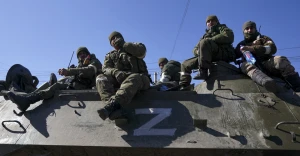
Explosions at Ukrainian recruitment centers: Russia wants to show people’s riots against government
Russian special services are recruiting the poor and fools in Ukraine to carry out suicide missions. Against this backdrop, Russian propagandists are actively spreading statements about mass riots in Ukraine
The recent waves of arson attacks on military vehicles organized by Russia and its purchased “agents” now look like a played-out project. Now, it has started organizing terrorist attacks at recruitment centers.
Espreso explains how Russia benefits from the "existence" of sabotage and unrest in Ukraine.
What happened with Ukrainian recruitment army centers
Over the past week, a wave of terrorist attacks has swept across Ukraine near recruitment army centers. Explosions occurred near or at the recruitment centers in Rivne, Pavlohrad in the Dnipropetrovsk region, and Kamianets-Podilskyi in the Khmelnytskyi region. The underminers were the ones who died, with some being remotely neutralized by their supervisors.
For example, Russia enlisted a 21-year-old unemployed man to carry out the explosion in Rivne. The improvised explosive device was hidden in his tourist backpack. As the man entered the recruitment center, the Russians accessed his phone camera to confirm his location and then remotely detonated the explosive by calling his phone. The man died instantly.
Two more young men were detained for attempting a terrorist attack in Chernivtsi, where they had set up an improvised explosive device. In Kyiv, a 22-year-old Lviv resident was preparing a terrorist act near one of the Security Service of Ukraine (SBU) units. A bag containing an improvised explosive device with a capacity of 7 kg of TNT equivalent was found on the detainee's person.
Equally alarming is the case of the murder of a serviceman at a gas station in Pyriatyn. An officer of the Poltava recruitment center was killed there as a result of a gunshot wound.
How Russian special services enlist people
Ukrainian journalists investigated how enemy-recruited people are enlisted — they managed to reach Russian special services almost by accident - an acquaintance of one journalist noticed graffiti in a dark alley with the address of a Telegram channel. This channel was filled with content discrediting the Armed Forces of Ukraine and calling for the disruption of mobilization.
The same channel also posted a price list for various acts of sabotage. For example, potential traitors to Ukraine were offered $100 for providing personal data of Ukrainian recruitment officers and $5,000 for setting fire to a recruitment center building.
Why have recruitment centers become target of Russian propaganda?
Russian information warfare has been attacking the Ukrainian military for a long time. However, as the number of army volunteers decreased in the third year of the war, recruitment center officers - responsible for mobilization - became a key focus of efforts to discredit Ukraine’s Defense Forces.
Ivan Tymochko, head of the Armed Forces Reservists Council, told Espreso that Russia has long been cultivating social media groups trained to resist recruitment center officers.
Meanwhile, the image of recruitment centers has already been viewed ambivalently by Ukrainian society. Problems in the mobilization process, as well as conflicts between recruitment officers and civilians — including arguments and even physical confrontations — have led to a more negative public perception of recruitment centers.
This has become a fertile ground for Russian special services, who, with the help of useful idiots in Ukraine, have been actively trying to exploit it to disrupt mobilization in the country, spreading manipulations about recruitment centers among the people.
Videos of conflicts between recruitment officers and civilians are gaining thousands of comments on social media, giving the impression of a widespread phenomenon in Ukraine. On the contrary, statistics show that while one or two videos of public conflicts between civilians and recruitment center officers appear online daily, these incidents make up just 0.0002% of all interactions between recruitment centers and the public - thousands of which happen every day.
This week, the Russians took another step in their efforts to destabilize Ukraine by organizing a series of explosions at Ukrainian recruitment centers. Through these explosions, Russian special services were clearly trying to impose a new message that, amidst the dissatisfaction with the actions of recruitment centers, people in Ukraine are beginning to fight back and sabotage them.
Russian narrative: “Ukrainians are rebelling against the recruitment centers”
Since the beginning of the full-scale invasion and the start of mobilization in Ukraine, Russia has been attempting to disrupt mobilization through information warfare. According to the recruitment centers themselves, the following narratives have been used by the Russian influence campaign for the past three years:
- "The recruitment centers are a private organization."
- "The recruitment centers were formed illegally."
- "There are no legal entities such as the recruitment centers."
- "There is no state of war in Ukraine, so mobilization is illegal."
- "The recruitment centers are not the Armed Forces."
- "The recruitment centers are staffed by those who have ‘paid off’ service in combat units or have been hired for money or by acquaintance."
- "Checking citizens' documents by recruitment center officers is illegal."
- "The recruitment centers kidnap people."
- "They mobilize everyone."
- "The recruitment centers do not stop expensive cars, only ordinary people."
- "Detained by the recruitment centers are kept in inhumane torture chambers, and people die."
- "There is corruption everywhere in the recruitment centers."
Recently, Russia has added one message to this rhetoric: “Ukrainians are rebelling against the recruitment centers.”
We recorded that some of the first reports of “riots” in Ukraine appeared in the summer of 2024. At that time, the Russian website Mk.ru wrote that “the first riot is ripe in Western Ukraine” and about the “siege of the recruitment center.”
https://www.mk.ru/politics/2024/08/04/na-zapadnoy-ukraine-sozrel-pervyy-bunt-protestuyushhie-vsyu-noch-osazhdali-tck-v-kovele.html
Since then, almost every public incident involving the recruitment centers has been actively presented by the Russian side in the Ukrainian information space as a mass revolt against mobilization and the recruiting centers themselves.
Last week, for example, the Russian media wrote about the explosions at the recruiting centers as revolts against mobilization, obviously not mentioning that these attacks were organized by Russian special services.
This way, propaganda uses the classic technique of splitting society, with “the recruitment centers on one side and the people on the other.” The goal of the enemy's actions is to disrupt mobilization and increase tension in society, leading to internal confrontation.
According to Espreso journalist Olha Len, the explosions of the past week symbolize that the Russians are trying to organize something “bigger inside Ukraine.” And these individual incidents, according to Russians’ calculations, should raise the degree of tension to the appropriate level.
Ukrainian security forces counter arsons and terrorist attacks
The Security Service of Ukraine (SBU) and the National Police have identified 497 people involved in arson attacks on Armed Forces vehicles and attempted bombings near recruiting centers.
First Deputy Head of the SBU, Serhii Andrushchenko, announced this during a briefing alongside National Police Chief Ivan Vyhivskyi.
According to Andrushchenko, arrests are happening around the clock. "We have solved every case. Since the start of 2024, the SBU and the National Police have identified 497 individuals responsible for these crimes," he stated.
He added that the SBU is working proactively to counter Russian intelligence and sabotage operations, which are behind these attacks.
Conclusions
Despite Russia's attempts to portray last week's bombings and other sabotage acts as a sign of Ukrainian riots against the government, this narrative is not gaining traction among the public. The evidence that these acts were organized from outside, rather than from within Ukraine, is undeniable.
Moreover, the killing of those who carried out these explosions serves as a clear warning - those who take Russian money and follow their orders often meet the same fate: elimination by Russian special services.
At the start of the full-scale war, Russians believed that Ukrainians would welcome their army with flowers. The war revealed a different reality. However, as seen in the recent attacks on recruitment centers, this myth still persists within Russian intelligence agencies, security forces, and Putin himself. As a result, they continue staging incidents to uphold this narrative, unsuccessfully portraying fake acts of sabotage as Ukrainian public uprisings against the government.
- News













































